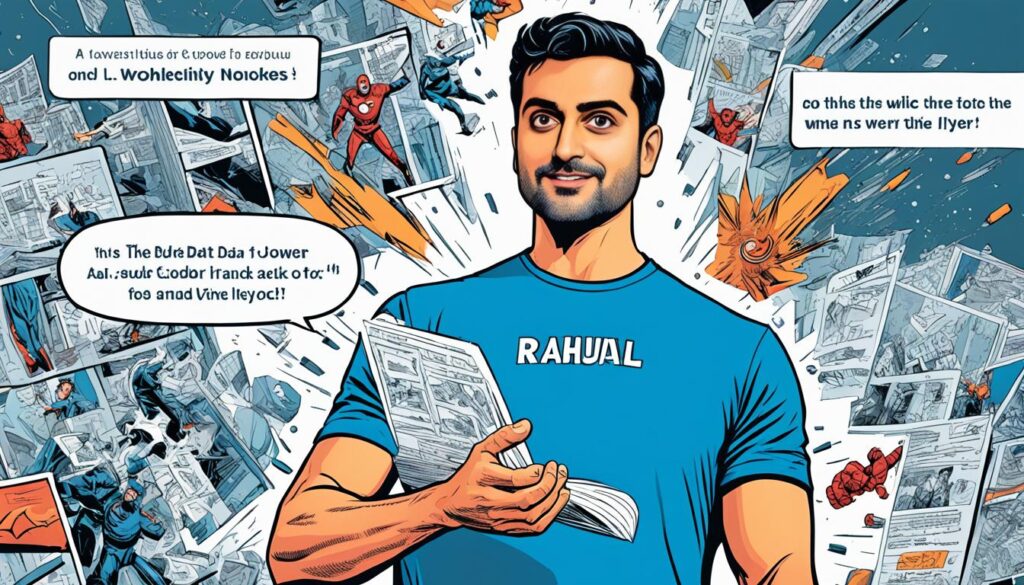Imagine you’re a marketing exec getting ready to show your company’s sales from the last year. You look at the heaps of data on spreadsheets, feeling overwhelmed. How can you make all these numbers clear and interesting for your team?
Data visualization turns this challenge into an opportunity. It changes raw data into engaging charts, graphs, and infographics. This makes information not just more attractive but easier to grasp. With data visualization, you can spot trends and insights that might have been missed.
Research points out a major hurdle in data visualization is avoiding misleading presentations. Using an incorrect chart can create confusion and wrongly interpret the data. This underlines the need to pick the most suitable visuals for clear understanding1. Also, it’s vital to keep things simple. You must present complex data in a format that everyone can understand1.
Now, imagine boosting your data visualization with AI’s power. AI, especially in big language models and generative AI, is set to transform data visualization2. It makes finding, summarizing, and combining data for analysis quicker and more precise2. Language-based analysis is getting popular across sectors, offering better insights and decisions2.
The vast increase in data highlights the urgency for skilled data visualization. By 2025, the world will create over 180 zettabytes of data, 80% of which will be unstructured3. There’s a growing need for pros who can navigate data visualization and AI effectively3.
Key Takeaways:
- Data visualization is crucial for effectively communicating complex data.
- Choosing the right chart type is essential to avoid misrepresentation.
- Simplicity is key in making complex data accessible to diverse audiences.
- AI applications have the potential to revolutionize data visualization.
- The demand for professionals skilled in data visualization and AI is projected to increase.
The Challenge of Misrepresentation
In the world of data visualization, avoiding misrepresentation is key. Misleading graphs and charts can skew the data. This might lead to wrong conclusions. Such errors can affect healthcare, finance, and policymaking greatly.
About one third of all medical graphs have shown to be misleading4. This shows we must be careful with data in healthcare. Wrong data can risk lives and decisions in this field.
Knowing different chart types helps address this issue. For instance, bar charts are great for showing statistics clearly4. They help compare different values or categories well.
Choosing the right chart can be hard with complex data. That’s where AI tools can help. They use algorithms to pick the best chart type4. This lowers the chance of showing the data wrongly.
AI tools have changed how we visualize data. Instead of guessing, we now have precision. This leads to clearer and more accurate charts.
Trainings that improve perception can also help. They’ve worked for police in reducing biases4. Such trainings could enhance our understanding of graphs.
Still, we don’t know how much feedback helps in spotting misleading graphs4. More studies are needed in this field.
To sum it up, getting data visualization right is tough but vital. With the right tools and knowledge, we can avoid misrepresentation. This ensures our data tells the true story.
“The use of AI-driven tools in data visualization has transformed the way professionals approach the task.”
Simplifying Complexity
Many experts think that making things complex shows deep knowledge in data visualization. But, too much complexity in charts and visuals can confuse people and make it hard for them to understand.
The rise of AI technology is changing how we show complex data by making it simple. AI helps by turning complicated data into visuals that are easy to get and fun to look at. This makes it easier for people to engage with the data and find important meanings.
AI tools for data visualization let experts quickly go through big and complex data sets. They can find patterns, trends, and insights that would be tough to spot on their own. These tools analyze data by themselves, saving time and effort needed to process and show the data.
Using AI to make complex ideas simple helps professionals share information with more people. They can show hard concepts in an appealing way. This lets viewers understand the main points and make decisions based on what they learn.
Professionals can mix AI’s power with easy design rules to make visuals that are both smart and straightforward. The aim is to show complicated info in a way that’s easy to get without missing the important parts.
When making data visuals, it’s key to think about who will see them and how much they know about the topic. Knowing what users need and how they act is essential. This helps in making visuals that meet their specific needs.
Using the same layouts, chart types, and styles across dashboards makes it easier for people to use them. This standard way of doing things helps users understand the visuals better. As a result, they can make good decisions and find useful insights.
Stories also help in making complex ideas simple. By adding storytelling to data visuals, experts can lead viewers through a story. This makes the info more interesting and easier to remember.
It’s worth saying that simplifying doesn’t mean making things too simple or losing valuable analysis. AI tools for data visualization can manage complicated data sets. They offer deep insights while making the info easy to access.
Companies should work on setting and improving rules for making data visuals. By focusing on simplicity and using AI, experts can make the most of their data. They can share insights in a clear way that helps in making smart decisions.

| Data Visualization Statistics | Reference |
|---|---|
| Many organizations are adopting self-service BI tools like Tableau and Microsoft Power BI. | 5 |
| Developers, analysts, engineers, and managers are increasingly involved in developing data visualizations and dashboards. | 5 |
| It is crucial to establish data visualization standards within organizations. | 5 |
| Visualization dashboards are essential for understanding data and extracting insights. | 5 |
| Asking pertinent questions about data quality, need for data prep and cleansing, and analytics during the initial phases of developing dashboards is important. | 5 |
| Defining the audience, purpose, and utility of a visualization aids in its design. | 5 |
| Consistent layouts, chart types, and styles across dashboards improve user experience and understanding. | 5 |
| Visual storytelling elements help in conveying insights effectively. | 5 |
| New dashboards often expose data quality issues that need addressing. | 5 |
| Ongoing enhancements and updates to data visualizations are necessary as business objectives evolve. | 5 |
| Organizations should establish and improve development and design standards for data visualization practices. | 5 |
Tailoring to Audience Needs
Effective data visualization is all about meeting the specific needs of your audience. A general approach can lead to confusion and poor communication. Thanks to AI, we can now analyze who our audience is and what they prefer. This lets us craft visualizations that hit the mark6.
Using AI, professionals create data stories that resonate with each viewer. This boosts engagement and comprehension. AI helps marketers break down their audience, customize content, pick the best times to send emails, and write attractive email headlines6. AI’s role in email marketing leads to more personalized messages, accurate predictions, focused efforts, and greater efficiency6. Marketers can shape their campaigns to match their audience’s likes and actions. This leads to more effective campaigns and higher sales.
Yet, it’s important to note AI in email marketing has downsides too. These include creative limits, legal and privacy issues, high expenses, possible bias, and setup challenges6. Still, with proper planning, setting clear goals, choosing the right AI tools, and continuously refining strategies, businesses can use AI to win over and convert their intended customers6.
Mastering Data Visualization with AI: The Learning Journey
Learning to master data visualization with AI is an exciting journey. It helps professionals tap into data’s full potential. Thanks to the progress in AI and ML, these tools can now make data visualizations that are not only beautiful but also full of insights.
Understanding complicated data becomes easier with powerful visualization tools. Professionals can use AI to improve their skills in making dynamic and interactive visuals. These visuals help in making smart decisions based on clear insights.

Only a few industry professionals truly understand the current hype around AI and machine learning7.
AI makes it possible to tackle real-world problems and discover hidden trends in data. With AI-powered tools, professionals can sift through large data sets. They transform complex information into visual stories that help in decision-making.
It’s key to understand that we are not yet at the stage of AGI or singularity7. While AI and ML are great at recognizing patterns, they don’t fully understand like humans yet7. But, AI and ML already bring a lot of benefits to the table7.
The author proposes a 3-month program for individuals interested in starting their journey in AI and ML7.
The “Machine Learning” course by Stanford on Coursera is a great first step. Andrew Ng, a leading AI expert, teaches it7. It takes about 11 weeks, but some finish in less time while doing other things7.
The “Machine Learning” course on Coursera by Stanford University, led by Andrew Ng, is estimated to take about one month to complete7.
Although the course is free, a certificate costs $79, with financial help available7. It covers linear algebra, calculus, and Python programming – essential for starting in AI and ML7.
| Duration | Tuition Cost | Format | Semester of Entry |
|---|---|---|---|
| 12 weeks | $5,950 | Online | Fall, spring |
Georgetown University offers a structured 12-week certificate in data visualization and AI. It costs $5,950 and covers various topics8.
The course duration is 11 weeks, but the author managed to finish it in under a month while engaging in other activities7.
Georgetown also has options to help with costs, like the Tuition Assistance Program. It covers most of the tuition for eligible workers. They also offer a payment plan for programs over one month and more than $4,000 in tuition8.
International students don’t need the TOEFL to join, but they should be fluent in English8.
Starting this journey opens many doors for professionals. By improving their skills with AI, they can change how data is used. Whether choosing online courses or structured programs, learning about AI and data visualization is rewarding7.
About Rahul Iyer
Rahul Iyer stands out in the world of data visualization. He is the driving force behind Advanced Innovation Group Pro Excellence (AIGPE™). His role as founder and CEO shows his leadership in quality management and project management. Through his deep knowledge, Rahul has guided professionals in many fields to learn data visualization skills.

Rahul Iyer is highly qualified in data visualization. His qualifications include IT and Cloud Computing certs from AXELOS Global Best Practice and Microsoft, earned from March 2022 to December 20229. Additionally, he is a Certified Quality Engineer (CQE) and a Certified ScrumMaster (CSM®)9. Rahul’s drive for perfection doesn’t stop with his career; he also mentors and leads at Toastmasters International9.
Rahul Iyer’s vast education supports his expertise. He has studied various engineering fields and project management9. This educational background helps him solve complex issues in data visualization.
Since 2013, Rahul Iyer has worked on many projects. These have included certification processes and quality assurance documentation. He has also worked on capital improvement projects from 2013 to 20169. His projects cover a broad spectrum, including software development and manufacturing process optimization. Rahul’s skill in machinery rebuilds and manufacturing processes comes from his extensive experience9.
Conclusion
Data visualization with AI technology changes the game for people wanting to fully use their data10. It turns complicated info into clear, powerful stories. This helps professionals make smart choices and push their businesses forward. Also, AI improves data visuals in accuracy and effect, making them even better11.
Good data visualization isn’t just about pretty charts and graphs. It’s about making sure everyone can get the info they need10. To include everyone, it’s critical to have text descriptions, tables, clear labels, and colors that stand out for those who see differently10. Things like white space, patterns, and shapes also help make visuals easy to understand, even for those who are color-blind10.
Visuals like charts, maps, and graphs are key to understanding data fully12. They give new views and help spot trends and connections, leading to big insights for decisions12. Writing down what you find and what actions you take is also key. It helps make sense of the data and make smart choices12.
AI and machine learning make data visuals more accurate and fair by cutting out mistakes and biases11. There’s a lot more interest in making data easy for everyone to use and understand. Tools like Opendatasoft let people create their own data visuals without needing to code, helping them share insights easily11.
Leveraging data visualization with AI helps professionals tap into their data’s full power. It improves decision-making and boosts business growth. Start using AI in your data visualization now. Embrace AI to change complex data into stories that have a big impact .










